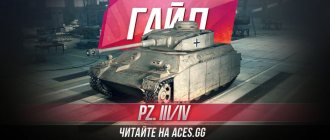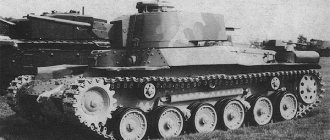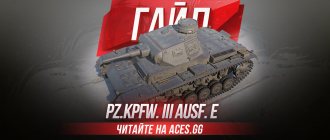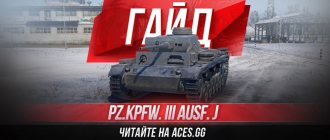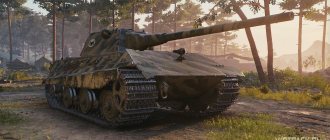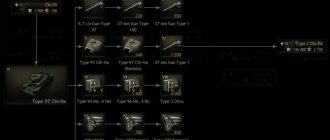Hello everyone and welcome to aces.gg! Friends, today we will talk about a very interesting and powerful unit with a long and incomprehensible name, we are talking about a German premium medium tank of the third level - this is the Pz.Kpfw.
S35 739 (f) guide .
If we talk about the origin of this vehicle, then it is considered a trophy (captured by the Germans from the French). This miracle costs only 1000 gold, however, it is better to wait for some promotions during which Pz.Kpfw. S35 739 (f) buy
possible at a better price.
TTX Pz.Kpfw. S35 739 (f)
As usual, we’ll start with the fact that this unit has at its disposal a fairly standard margin of safety, as well as a good, but far from record-breaking basic visibility of 300 meters. Regarding the level of battles, it is with the Pz.Kpfw. S35 739 (f) World of Tanks
full-fledged, so from time to time you will have to suffer in confrontation with the fives.
Things are much more interesting with the armor of our French German; the frontal armor can rightly be considered good. If we talk about the hull, the thickness of the front armor plates varies from 36 to 42 millimeters, similar to the Pz.Kpfw. S35 739 (f) characteristics
allow you to tank machine guns and even some enemy cannons.
The tower deserves special attention, since the areas marked in red cannot always be penetrated even by level five vehicles; here the thickness of the armor ranges from 56 to 128 millimeters. Cheeks Pz.Kpfw. S35 739 (f) WoT
They are also a difficult target due to their thickness of 53-93 millimeters and rational streamlined shape. Even the commander's cupola is protected quite well and only the small blue area can be shot through quite easily; the metal here is only 38 millimeters thick.
Regarding the sides, the situation is somewhat aggravated. This large blue area is 35 millimeters thick, which still gives the Pz.Kpfw. S35 739 (f)
the ability to withstand shots from machine guns, but no longer saves classmates from ordinary guns. However, when the tank is positioned in a diamond shape, on its side, it can tank quite well.
If you look at the stern, from this angle we are the worst protected; only a measly 25 millimeters of armor separates us from inevitable damage. However, the circular armor of the tower is still pleasing.
In terms of mobility, the medium tank Pz.Kpfw. S35 739 (f)
not a record holder, you still have to pay something for a serious reservation. The creator has endowed us with a limited maximum speed, a meager supply of horsepower, which is why the dynamics are seriously lame, as well as mediocre agility.
One among strangers – 6. S35: the best of the Chevaliers
One of the most famous and interesting trophies of the Germans after the implementation of the Gelb plan was the French medium tank S35 Somua.
The history of the vehicle dates back to January 1932, when the French army issued technical requirements for an AMC type tank (Automitrailleuse de Combat - armored combat vehicle). The vehicle was intended not only to support infantry, but also to combat armored vehicles and enemy fortifications.
The Renault company zealously took up the work, but in 1934 the TTZ (increased armor and, as a result, weight) was revised, and it essentially found itself out of work, like other companies. And in order to get out of a seemingly deadlock situation, the cavalry leadership turned to SOMUA (a subsidiary of Schneider). The development contract was awarded in October 1934.
And after 7 months, by mid-April 1935, the prototype was ready and received the designation AMC SOMUA Type AC3. This speed of development and construction is primarily due to the fact that the suspension and transmission were partially borrowed from the Czech Lt.35 tank. This was facilitated by Schneider engineers who worked at Skoda factories for some time. Essentially, industrial espionage in action.
The new tank had problems with its power plant. Despite the fact that SOMUA produced tractors for the army, their engines were not suitable for the new tank. Javier Sabin helped solve the problem. The stated vertical armor was from 25 to 35 mm, the MTO roof and bottom were from 12 to 20 mm. Although tests in Kubinka of the captured S35 showed different characteristics: the frontal part was 45 mm, the thickness of the sides was 40-45 mm. The armament of the experimental tank (as well as the four pre-production tanks) consisted of a 47-mm SA34 cannon and a coaxial 7.5-mm machine gun, and all this was mounted in an ARX1-type turret. Production tanks received an improved ARX 1SE model turret with an extended shoulder strap and a new 47-mm SA35 U34 gun. An armor-piercing projectile with a protective tip, at a speed of 671 m/s, pierced a 40-mm armor plate installed at an angle of 30° from a distance of 500 meters, and a conventional projectile pierced a 33-mm armor plate from the same distance. Nevertheless, the turret remained single-seat, which made life very difficult for the tank commander.
The tank prototype was tested from July 4 to August 3, 1935. The military made a number of comments and suggestions, and after making changes (the second stage, from October 15 to December 17, 1935), no improvements were identified. But the cavalry had a great need for new tanks, and therefore, without waiting for full testing, an order was made for 50 units. The tank received the official designation Char 1935 S (Tank 1935 S), although later another name became more common - SOMUA S35.
SOMUA S35
Due to haste, the first production cars came out with many defects. In fact, additional testing continued until April 1938. In the same month, the cavalry nevertheless accepted the S35 into service. An interesting feature was the presence of a differential rotation mechanism; control was carried out by a steering wheel.
This resulted in the fact that the minimum turning radius of the S35 was greater than that of tanks that had side clutches, since it was impossible to completely stop one track. When performing other maneuvers, this specificity was preserved; good training of the driver was required.
By September 1, 1939, the French army had 270 S35 tanks; after the announcement of mobilization and then war in Germany, the production of tanks began to increase. By June 25, 1940, SOMUA had produced 427 S35 tanks.
The S35 received its baptism of fire, like the vehicles we talked about in previous articles, during the French campaign of May-June 1940. Despite their qualitative superiority over German tanks, the French were unable to delay the Germans in border battles. For example, in the battle for Hannut (Belgium), which took place from May 12 to 15, and in which S35 took direct part.
The German concentrated attack tactics played an important role, and as a result of the battles, more than 60 tanks of this type were lost.
S35 tanks also took part in the battle of Aras, but the successes were quite modest. And Charles de Gaulle, who received 36 tanks at his disposal, spoke about them as follows: “...Meanwhile, I received for replenishment the 3rd Cuirassier Regiment, consisting of two squadrons of SOMUA tanks. However, the tank crews were headed by commanders who had never fired a gun before, and the drivers had a total of no more than four hours of driving a tank under their belts…”
By June 22, 1940, the French had approximately a hundred SOMUA tanks remaining, 23 of which were left to the Pétain government. The total number of captured tanks was 297 units. These vehicles received the German designation Pz.Kpfw.739(f) and were partially modernized. Namely:
— German radio station FuG5 was installed;
— the commander’s cupola received a double-leaf hatch;
— the fighting compartment was completely rearranged, and the turret became a two-seater turret.
Pz.Kpfw.739(f)
Despite the fact that the tank was inferior to the Pz IV in driving performance, its armor and armament were quite suitable for operations at the front.
S35 Somua tanks were equipped with five tank regiments (100, 201, 202, 203, 204 Pz.Rgt. - Panzer-Regiment) and 10 separate tank battalions (Pz.Abt. 40, 202, 205, 206, 211, 212, 213, 214, 223, 301 - Panzer-Abteilung). In December 1940, 201 Pz.Rgt was created. two battalions.
In total, the tank regiment had 36 S35 and 82 N-38/39. In January 1941, the 301st tank battalion was created on French territory, and in February - the 202nd tank regiment (of two battalions). And in March 1941, these two units were combined into the 100th Tank Brigade (Pz.Brig.100). In total, for this period there were 295 tanks (90 S35 and 205 N-38/39).
Among the units that were armed with the SOMUA tank were also: a separate tank battalion “Wolf” (future 211 battalion), 100 training tank battalion (training to work with captured armored vehicles), 201 and 202 tank regiments. And just before the invasion of the USSR, the creation of the 101st brigade of captured tanks began (consisting of two tank regiments 203 (Pz.Rgt.203) and 204 (Pz.Rgt.204).
By July 1, 1941, the Germans had at least 472 French tanks (144 of them S35) in the 101st and 101st tank brigades in the first line, not counting the vehicles in the 100th training battalion, 211th and 204th regiments.
Training S35
When the 22nd Panzer Division was formed in September 1941, its personnel received S35 tanks, but they were later replaced by Czech Pz.38(t). There was also the 203rd tank regiment, from the 23rd tank division, but the tanks there were replaced with Pz IVs. And Somua tanks were sent to Finland, where the 211th regiment (211 Pz.Abt) was subordinate to the command of Army Group North. Not all units fought on the Eastern Front. Some of the tanks were even transferred to Germany’s allies: Bulgaria (~6-7), Hungary (2), Italy (32), Croatia (20).
In addition to all this, S35 tanks entered service with armored trains. By June 22, 1941, six units were concentrated to attack the USSR. Armored trains No. 26, No. 27 and No. 28 each had 3 tanks, No. 29, No. 30 and No. 31 each had two, for a total of 15 vehicles. The platforms were equipped with ramps for “landing” tanks.
German armored train No. 28 Stolbtsy station (Minsk region), summer 1941. Photo from forum fortification.ruThe first military clash with units of the Red Army happened for the “French” in the Brest Fortress, on the Kobrin fortification (Northern Island) near the Eastern Fort. At first, their use seemed very vague, because... the command did not quite understand how to use armored train No. 28 in the battles for the city of Brest and the fortress. The situation was further complicated by the fact that the tanks had no shells at all. The problem was eliminated virtually on the eve of the war.
The tanks went into battle on June 23. Most likely they were requested to strengthen the attackers, because the use of Stugs the day before did not bring much success. According to available information, two tanks were knocked out at the Kobrin fortification near the Northern Gate with grenades and an anti-aircraft gun (most likely a 76.2 mm 3-K 393 OZAD gun), the third tank nevertheless broke into the courtyard of the citadel and was knocked out by a gun from area 333 SP. Two of the three tanks were evacuated. According to other sources, three tanks were used on June 26, but also without much success.
Tank Pz.Kpfw.739(f) at the Northern Gate of the Brest Fortress
Tank Pz.Kpfw.739(f) during the assault on the Eastern Fort
It was possible to break the resistance of the defenders of the Eastern Fort only by dropping 1800 kg on the fort on June 29. air bomb.
Subsequently, S35 tanks were used sporadically. This was in the fall of 1941, most likely in the Smolensk region.
Tank Pz.Kpfw.739(f), Eastern Front, September 1941
Tank Pz.Kpfw.739(f), Eastern Front, destroyed on the outskirts of Moscow, 1941
In the spring of 1942, as part of the 22nd Tank Division, these tanks stormed Sevastopol. And a little later in the battles of Stalingrad, where one tank came to us as a trophy.
Captured Tank Pz.Kpfw.739(f)
By the beginning of the summer of 1943, only two S35 tanks remained on the central sector of the Eastern Front. The rest served in France (67), Yugoslavia (43), Scandinavia (32), and 15 units remained in service with armored trains.
211 battalion (211 Pz.Abt), which, as stated above, arrived in Finland in the summer of 1941. S35 tanks served as command vehicles in platoons equipped with N-39s. Most of the time the vehicles were in the corps reserve, until the summer of 1944 they were located in the Kandalaksha direction in the Kuolojärvi area. To repel the advance of the Red Army, the Finns and Germans were forced to use all available armored vehicles, and the 211th regiment had a hard time.
On the night of September 9-10, company S35 was sent to reinforce German units in the Kandalaksha direction. Moving along the Miokkalahti-Kuolajärvi road, German tanks were ambushed by three Soviet T-34-76s, which the Germans themselves wanted to ambush, but due to the darkness, the Soviet tanks simply slipped through the dangerous area. Confusion arose, and both sides mistook enemy tanks for their own. The crews of the “thirty-fours” reacted faster, and immediately the first S35 received three shells, a minute later the second tank was set on fire, the crews of the remaining tanks decided for their own good to leave their vehicles and retreat. According to some data, the Soviet units received 6 undamaged tanks, according to others 8. After a quick inspection, it was decided to include the surviving captured tanks in the attacking units. They were refueled, equipped with crews from the reserve regiment and sent into battle. The tanks that survived the battle were sent to Kubinka.
In addition to the Eastern Front, S35 tanks appeared on other fronts. The Germans also converted 60 tanks into tracked tractors, which were used on both fronts (Western and Eastern).
Dimensions: Body length, mm - 5380. Body width, mm - 2120. Height, mm - 2630. Ground clearance, mm - 420.
Armor: Armor type: cast steel, homogeneous. Body forehead (top), mm/deg. - 36 / 22°. Body forehead (bottom), mm/deg. — 36 / 0—90°. Hull side (top), mm/deg. — 35 / 22°. Hull side (bottom), mm/deg. — 25+10 / 0°. Hull stern (top), mm/deg. — 25 / 30°. Hull stern (middle), mm/deg. - 35 / 0°. Hull rear (bottom), mm/deg. — 25 / 30°. Bottom, mm - 20. Housing roof, mm - 12-20 / 82-90°. Turret front, mm/deg. — 56. Gun mask, mm/deg. — 56. Tower side, mm/deg. - 46 / 22°. Feed cutting, mm/deg. - 46 / 22°. Tower roof, mm - 30 / 72-90°.
Armament: 47 mm SA 35 U34 cannon. Ammunition: 118 shells. Machine gun: 1 × 7.7 mm mle.1931.
Mobility: Engine power, l. With. — 190 at 2000 rpm. Speed on the highway, km/h - 37. Cruising range on the highway, km - 260. Cruising range over rough terrain, km - 128.
Specific ground pressure, kg/cm² - 0.75. Climbability, degrees. — 35. Wall to be overcome, m — 0.75. Ditch to be overcome, m - 2.15. Fordability, m - 1.0.
Summary: The S35, as a tank, compared to its analogues at the beginning of World War II, was distinguished by relatively high characteristics of weapons and armor protection. The 47-mm SA 35 U 34 cannon was capable of effectively hitting any type of German tank, the thickness of which during the French campaign did not exceed 30 mm. At the same time, its ammunition included a relatively effective fragmentation projectile, which had twice the explosive charge of the Soviet 45-mm O-240 and was second only to shells from 75-mm or 76-mm guns at that time.
The armor of the S35, with a thickness of the vertical surfaces of the hull of about 40 mm, was designed for protection against first-generation anti-tank guns, which had a caliber of about 37 mm.
If we take 1940 as a level, then the S35 was probably the best medium tank. The combination of good weapons and armor allows us to say so. But with the massive appearance of the T-34 on the battlefield, the S35 became history.
Sources AFV Weapons Profile 36 Chars Hotchkiss, H35, H39, and Somua 35. Trackstory 01 - Somua S 35. Walter J. Spielberger - Beute-Kraftfahrzeuge und-Panzer der deutschen Wehrmacht (Band 12 der Reihe "Militarfahrzeuge"). Armor collection No. 1998-04 (19). Armored vehicles of France and Italy. Kolomiets M., Moshchansky I. 1939-1945. Spasibukhov Yu. Armor collection No. 2004-03 (54). French tanks of the Second World War (part 1). Tornado. Army series 16. Armored vehicles of France 1940. Military chronicle. The tragedy of Brest. Combat operations on the territory of Belarus. June 22 - July 23, 1941. https://armor.kiev.ua/Tanks/WWII/f/. https://www.aviarmor.net/tww2/tanks/france/somua_s35.htm. https://fortification.ru/forum/index.php?topic=245.0. https://photo.qip.ru/users/modeller11.photofile/200737469/all/?mode=xlarge. https://samlib.ru/n/nikolaj_b_d/nnikolaj_b_dtrofei.shtml/stat.shtml.
gun
The armament of our Germans, like the armor, deserves respect. No, of course, the gun is not very strong, but here we will find a lot of very pleasant parameters.
Let's start with the fact that Pz.Kpfw. S35 739 (f) gun
has a good alpha strike and a good rate of fire, due to which we have the ability to inflict almost 1500 units of damage per minute.
The penetration characteristics of a basic projectile are more than enough to comfortably penetrate almost all classmates, but due to the likelihood of getting into level five battles with Pz.Kpfw. S35 739 (f) WoT
It’s better to carry about 20-30% of gold ammunition.
As for the comfort parameters of dealing damage, everything is just fine here. Yes, the spread of our German is large, the stabilization is also poor, but the gun is brought down simply with lightning speed, which is why we are always ready to fire. By the way, Pz.Kpfw. S35 739 (f) World of Tanks
It has excellent elevation angles, the barrel drops by 10 degrees, so it’s a real pleasure to play with the sturdy turret.
Advantages and disadvantages
As you have probably already noticed, our tank has quite a lot of positive aspects, however, without knowing the shortcomings, it will be extremely difficult to realize the full potential of the vehicle. For this reason, we will now break down the most significant strengths and weaknesses of the Pz.Kpfw. S35 739 (f) World of Tanks
. Pros: • Well-armored turret; • Good armor from the front of the hull; • Decent alphastrike and DPM; • Good armor penetration parameters; • Good accuracy due to very fast convergence; • Comfortable vertical aiming angles. Cons: • Mediocre armor for the sides and stern; • Poor mobility; • Short viewing range; • The engine occupies the entire rear part of the body; • Full level of battles.
Is it worth buying Pz S35
The first and main reason to buy is the collection. This reason is relevant for fans of the game World of Tanks Blitz. The car really existed and has its own interesting history.
Purchasing for other purposes is very doubtful. You shouldn’t expect high returns from the third lvl premium. Even more - buying premium sand-level cars other than for a collection raises many questions. If you want to spend 350 rubles (about the cost of purchasing the required amount of game gold) and are happy with this beast, which you will roll out to random occasionally, then you can buy it. If the goal is to buy a car for business (farm, fun), then it’s not worth buying.
As for farming, below is the result of one average lousy battle:
Equipment for Pz.Kpfw. S35 739 (f)
We have a very limited number of variations in the selection of additional modules, which is due to the low level of technology, however, even here it is important to make the right choice. So, the most optimal solution would be to install a Pz.Kpfw on a tank. S35 739 (f) equipment
in the following form: 1. – the best choice, all other things being equal, in this way we get a complex boost that affects several important parameters at once. 2. – given our limited visibility and the full level of battles, this module looks very advantageous. 3. – among other options, this one looks the most worthy, and besides, it will make us less susceptible to artillery shots.
Someone might think that the third point could be replaced with , but the aiming speed of our gun is already sky-high, so we immediately reject such a decision.
Equipment for Pz.Kpfw. S35 739 (f)
The last thing to focus on is the choice of consumables. Despite the fact that our car is a premium one, you won’t be able to farm much on it, so in order to save money, it’s better to take , , . But if you don’t have problems with your silver reserves, and you want to get the most out of the game, take the Pz.Kpfw. S35 739 (f) equipment
from , , . The last option can be replaced with, but this is at your own peril and risk, because as already agreed, the engine occupies almost all the space at the rear, and when shots are fired at the side, stern or engine compartment from above, it may catch fire.
Premium in World of Tanks Blitz
In Wot blitz is the cheapest premium that can be purchased on an ongoing basis for 1200 gold. Often when describing this machine they use the term “disintegrator” or something like that. But the thing is that it occurs randomly and does not cause panic.
Prem is a medium tank and average in everything. He drives well, tanks well, and shoots well. And the general impression is that it is comfortable to play on. If you take sand-level machine guns, you can safely roll out on them without the risk of getting penetrated. Many enemies are penetrated by ordinary AP shells; if greater penetration is required, then gold shells will always help.
About survivability. This is a really well armored vehicle. The thickness of the armor of the front of the turret/hull is 56/36, the sides of the turret/hull are 46/35, the rear of the turret/hull is 46/25. We will be a difficult target for many opponents. But expecting that we are invulnerable is a big mistake. There will be enough opponents who will break through us. The enemy's tank destroyers will be especially dangerous for us.
About weapons. The tank is equipped with a 4.7 mm cannon, with AP/Gold penetration of 50/90. We will penetrate most enemies with conventional APs; if penetration is not enough, then a Gold shell will help out. But the damage is just over 50 units of the enemy’s strength. And if it is necessary to use sub-caliber shells, profitability can be significantly reduced. Rate of fire - just over 27 rounds per minute with potential damage of more than 1400 enemy strength units, good aiming - 1.4 seconds, turret rotation more than 40 degrees. sec.
About mobility. Engine power - 220 hp. gives more than 11 hp per ton. Maximum speed - 37 km/h. Chassis rotation speed - 40 deg.sec.
General impression. There is armor, but it does not give us an ultimatum in choosing actions - we can be penetrated. The weapon is quite nice, but the one-time damage is not enough. Our speed is low, but we move quite briskly. For light opponents who decide to spin us, the rotation speed of the chassis and turret will be an unpleasant surprise.
Prem is quite comfortable, but it’s far from a “disintegrator” and we don’t make our opponents panic. The game requires certain skills, but mistakes are forgiven.
Tactics of playing Pz.Kpfw. S35 739 (f)
Of course, to play effectively on any tank, you must always remember its strengths and weaknesses. In our case, there are many more advantages and this is good news, however, for the Pz.Kpfw. S35 739 (f) tactics
the conduct of the battle still depends on what level of fighting we are thrown into.
If we are at the top of the list, life is good. Our armor makes the difference here, there is enough penetration, and thanks to the rate of fire, the damage seems terrifying. In such realities, the medium tank Pz.Kpfw. S35 739 (f) WoT
capable of dragging, but there is no need to bury ourselves, we still act carefully and wisely. You should face your forehead to the enemy, with your body slightly turned, do not let anyone on your side or stern, and also beware of artillery.
In the battles at the bottom of the list, things are much worse, since we can’t do anything against some fifth levels. Here is Pz.Kpfw. S35 739 (f) tank
must play as carefully as possible. Charge your Golda and try to stay behind stronger allies, it makes sense to fire at a distance.
By the way, there is a position that is almost always beneficial for us - this is playing from the tower. This part of the tank is the hardest, and comfortable elevation angles make this tactic favorable. Being at the top of the list, this style of play allows the Pz.Kpfw. S35 739 (f) World of Tanks
take no damage at all. If we play from the tower against 5th levels, we have some chances of survival, because it becomes much more difficult to hit us, especially if we don’t stand in one place all the time.
